If you run out of propane, or don’t have a propane heater, there are still ways to keep yourself warm without it. How to heat an RV without propane goes beyond just running electricity. Learn how veteran boondockers keep themselves warm…
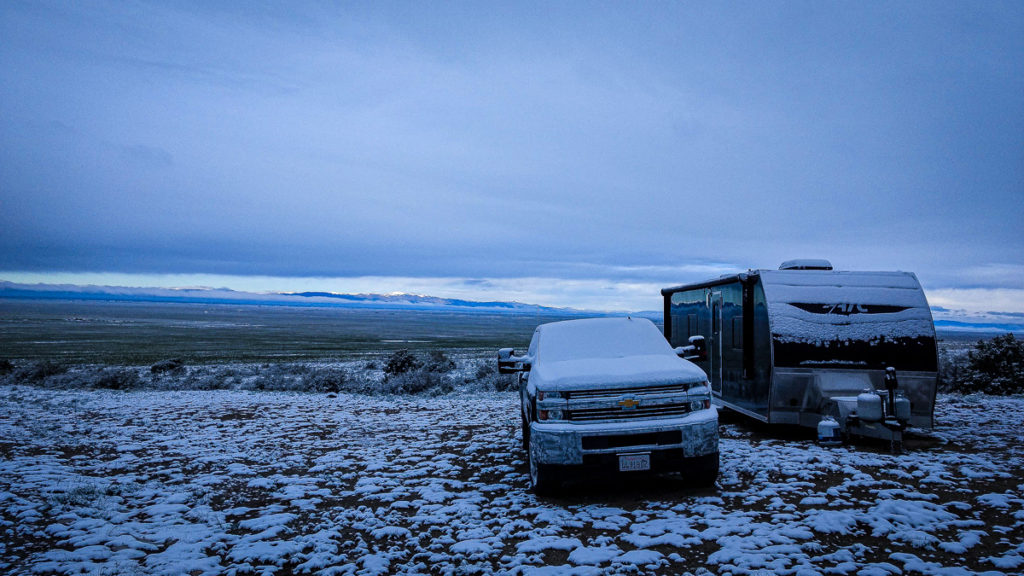
How to Heat an RV Without Propane
Most veteran boondockers use ceramic electric heaters powered by a gasoline generator to heat their RV when trying to minimize (or avoid using) propane. These small space heaters take up very little room, are very affordable, and work pretty well, especially when you use two of these units at the same time.
But this is just one way to heat an RV without using propane. Here is a list of ideas that many, if not all, boondockers rely on to keep themselves warm without propane…
Ceramic Electric Heaters
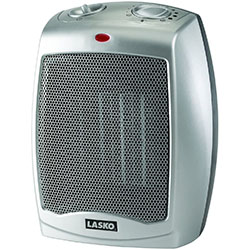
This is what every veteran boondocker has in their vehicle. This is just your old familiar electric heater with a fan inside to blow hot air. The difference is that they have a ceramic plate inside that absorbs the heat and helps it warm up a room more quickly than conventional electric heaters. Almost all electric heaters these days are ceramic heaters. These heaters generate between 5,000 to 5,200 BTUs of heat, and consume about 1,500 watts of electricity when running on their highest setting. The Lasko Ceramic Electric Heater is the most popular brand, and sells for about $35.00 each. They are sold everywhere including Walmart, Target, Lowes, Home Depot, and Amazon (see it on Amazon).
Infrared Electric Heaters
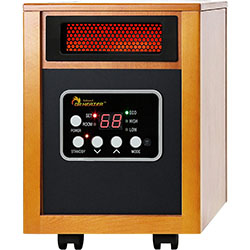
Infrared heaters produce bands of light that human eyes cannot see. These bands of light causes objects to heat up. These objects could be cabinetry, chairs and couches, and even yourself. They do not heat up the air, they only heat up objects. Those objects in turn, may radiate warmth into the air. They still produce the same volume of heat as ceramic electric heaters (5,000-5,200 BTUs) and still consume the same amount of electricity (1,500 watts). What makes them advantageous is that they produce no sound, which is perfect for light sleepers, and they do not get hot. They are more expensive than ceramic heaters (about $130.00), and are sold at every home improvement and hardware store. (See it on Amazon)
Oil Heaters
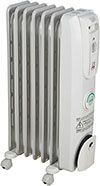
Oil heaters still require electricity to run, however they consume much less power than other electric heaters, yet produce just as much heat. They also make no noise when running. These units heat up a reservoir of oil and then uses the heated oil to the warm the air. The oil can retain its heat for about a hour or two. When it cools down, the unit reheats the oil again. Oil heaters can be advantageous for boondockers with small generators. The heater will consume a full 1,500 watts of power to reheat oil, but then drop down to just a trickle of charge, allowing you to use the generator for something else. Oil heaters also take longer to warm up than ceramic electric heaters. They generally cost between $60.00 to $100.00. (See it on Amazon).
Kerosene Heaters
While technically not propane, you may find a kerosene heater to be a better alternative to propane. They will produce double the heat as any of the electric heaters. While no electricity is required, most units still require batteries to generate spark. These heaters are large units, and will be too bulky to hang from a ceiling. Make sure to get a directional heater, not a 360 degree radiant heater. This is because you will likely want to set the heater in a corner of your RV and not have it burn into a wall. Also, make sure to buy a kerosene heater from a big box store like Lowes, Home Depot, or Menards, and do not buy it from Amazon. The reason is because units sold by Amazon come direct from China and you will receive no product support.
Wood Burning Stoves
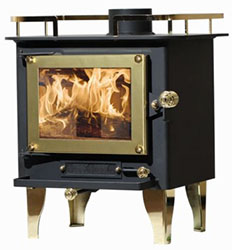
Wood burning stoves for RVs are getting more popular in the last couple of years due to higher prices of gasoline and propane. A couple of brands have emerged as front-runners in the field of RV wood-burning stoves, Dwarf and Cubic. Both make traditional-looking wood stoves in smaller sizes. See our other article for more details, “How Do I Keep My Camper Warm in Winter?“
Foam Tiles on the Floor
Interlocking foam tiles cut and laid down on the floor will help trap heat in your RV. It will also help keep your feet warm, and prevent you from stepping on puddles of condensation. (See it on Amazon).
Insulate Your Windows
Use Reflectix Sheeting over your windows to prevent heat from escaping your RV. If you still want sunlight to enter your RV, then use clear bubble wrap instead. You can buy Reflectix at Home Depot, Lowes, and Menards.
Block Off Your Roof Vents
The roof vent in your RV will allow heat to escape. You can buy a square-shaped roof vent insulator to stop heat from escaping. (See it on Amazon).
Using an RV Skirt
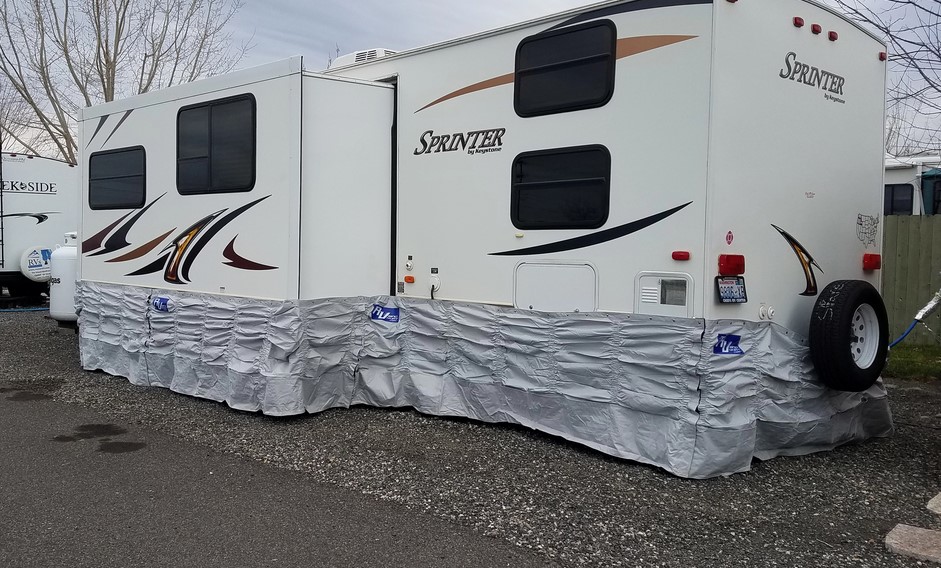
An RV skirt is a panel of flexible tarp that covers the gap from the bottom of your RV to the ground. If you run a skirt all around your RV, it stops the wind from blowing underneath. The reason why this works is because when wind blows freezing air under your RV, it will cause the floor to get icy cold. By blocking that wind, you can preserve more heat in your RV. An RV skirt will also keep your water lines from freezing.
There are companies that make RV skirts, but these skirts are very expensive. Most boondockers will use Reflectix Sheeting and tape it to the outside of their RV. You can also use several plastic storage bins (with the lids on) and line them around your RV. We’ve also seen boondockers cut out several panels of plywood and lean them against their RV.
Hot Hands
These are small packets that get really warm when you open the wrapper and expose it to the air. You can slip these packets into your gloves, or your pockets, or your socks. (See it on Amazon).
Hot Water Bottles
Hot water bottles allow you to use the heat from a campfire to warm your bedding, recliner, or couch. You can pour boiling water directly into a hot water bottle. A two-liter sized bottle is large enough to keep a bed warm for 4-6 hours. You can find these at any drug store like Walgreens, CVS, or Rite Aid.
Goose Down Comforter
Every RVing boondocker relies on a goose down comforter to keep them warm while sleeping or reclining. A goose down comforter can keep you toasty warm all by itself without any other blankets. This is an item where you DO NOT want to buy from Amazon. Go to a bedding store where you can inspect the product in person.
Look for comforters with “fill power” of 800 or higher. This refers to down density, the higher the more dense, and thus the higher heat-retention ability. Also inspect the stitching of each pocket-panel. You want to look for stitching that will not tear and allow down to travel throughout the comforter. Look for comforters with at least 600-thread count to prevent down-quill from poking through the fabric.
If you see a goose down comforter priced less than $200.00 for a queen size, don’t buy it. Run away from it, screaming.
Thick Socks
People who remain inside their RV tend to take their shoes off. This allows more heat to dissipate from your feet. When you add to that the fact that blood circulates more slowly in the feet, this gives blood more time to cool off in the lower extremities.
Get the thickest socks you feel comfortable in and wear them all the time. This will go a long ways towards keeping the rest of your body warm.

